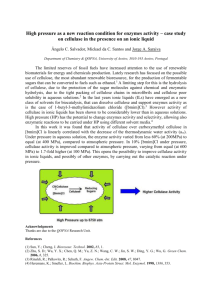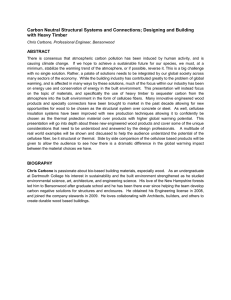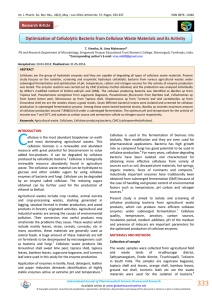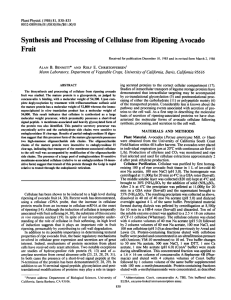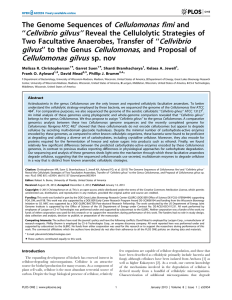Document 13309642
advertisement
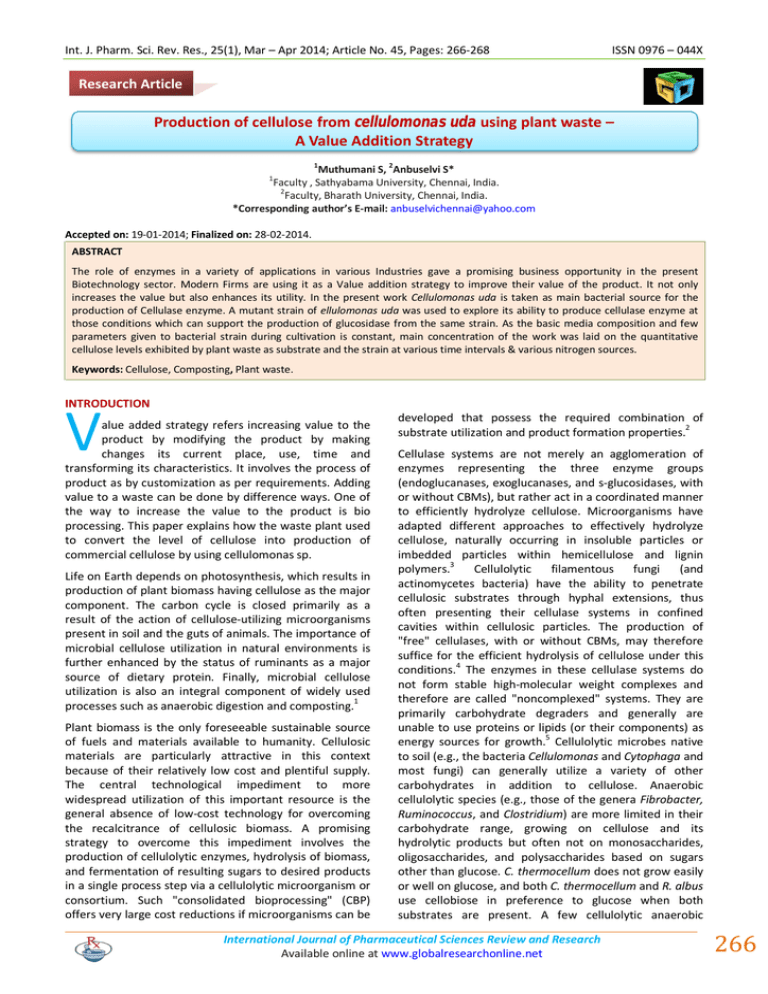
Int. J. Pharm. Sci. Rev. Res., 25(1), Mar – Apr 2014; Article No. 45, Pages: 266-268 ISSN 0976 – 044X Research Article Production of cellulose from cellulomonas uda using plant waste – A Value Addition Strategy 1 2 Muthumani S, Anbuselvi S* Faculty , Sathyabama University, Chennai, India. 2 Faculty, Bharath University, Chennai, India. *Corresponding author’s E-mail: anbuselvichennai@yahoo.com 1 Accepted on: 19-01-2014; Finalized on: 28-02-2014. ABSTRACT The role of enzymes in a variety of applications in various Industries gave a promising business opportunity in the present Biotechnology sector. Modern Firms are using it as a Value addition strategy to improve their value of the product. It not only increases the value but also enhances its utility. In the present work Cellulomonas uda is taken as main bacterial source for the production of Cellulase enzyme. A mutant strain of ellulomonas uda was used to explore its ability to produce cellulase enzyme at those conditions which can support the production of glucosidase from the same strain. As the basic media composition and few parameters given to bacterial strain during cultivation is constant, main concentration of the work was laid on the quantitative cellulose levels exhibited by plant waste as substrate and the strain at various time intervals & various nitrogen sources. Keywords: Cellulose, Composting, Plant waste. INTRODUCTION V alue added strategy refers increasing value to the product by modifying the product by making changes its current place, use, time and transforming its characteristics. It involves the process of product as by customization as per requirements. Adding value to a waste can be done by difference ways. One of the way to increase the value to the product is bio processing. This paper explains how the waste plant used to convert the level of cellulose into production of commercial cellulose by using cellulomonas sp. Life on Earth depends on photosynthesis, which results in production of plant biomass having cellulose as the major component. The carbon cycle is closed primarily as a result of the action of cellulose-utilizing microorganisms present in soil and the guts of animals. The importance of microbial cellulose utilization in natural environments is further enhanced by the status of ruminants as a major source of dietary protein. Finally, microbial cellulose utilization is also an integral component of widely used processes such as anaerobic digestion and composting.1 Plant biomass is the only foreseeable sustainable source of fuels and materials available to humanity. Cellulosic materials are particularly attractive in this context because of their relatively low cost and plentiful supply. The central technological impediment to more widespread utilization of this important resource is the general absence of low-cost technology for overcoming the recalcitrance of cellulosic biomass. A promising strategy to overcome this impediment involves the production of cellulolytic enzymes, hydrolysis of biomass, and fermentation of resulting sugars to desired products in a single process step via a cellulolytic microorganism or consortium. Such "consolidated bioprocessing" (CBP) offers very large cost reductions if microorganisms can be developed that possess the required combination of substrate utilization and product formation properties.2 Cellulase systems are not merely an agglomeration of enzymes representing the three enzyme groups (endoglucanases, exoglucanases, and s-glucosidases, with or without CBMs), but rather act in a coordinated manner to efficiently hydrolyze cellulose. Microorganisms have adapted different approaches to effectively hydrolyze cellulose, naturally occurring in insoluble particles or imbedded particles within hemicellulose and lignin polymers.3 Cellulolytic filamentous fungi (and actinomycetes bacteria) have the ability to penetrate cellulosic substrates through hyphal extensions, thus often presenting their cellulase systems in confined cavities within cellulosic particles. The production of "free" cellulases, with or without CBMs, may therefore suffice for the efficient hydrolysis of cellulose under this conditions.4 The enzymes in these cellulase systems do not form stable high-molecular weight complexes and therefore are called "noncomplexed" systems. They are primarily carbohydrate degraders and generally are unable to use proteins or lipids (or their components) as energy sources for growth.5 Cellulolytic microbes native to soil (e.g., the bacteria Cellulomonas and Cytophaga and most fungi) can generally utilize a variety of other carbohydrates in addition to cellulose. Anaerobic cellulolytic species (e.g., those of the genera Fibrobacter, Ruminococcus, and Clostridium) are more limited in their carbohydrate range, growing on cellulose and its hydrolytic products but often not on monosaccharides, oligosaccharides, and polysaccharides based on sugars other than glucose. C. thermocellum does not grow easily or well on glucose, and both C. thermocellum and R. albus use cellobiose in preference to glucose when both substrates are present. A few cellulolytic anaerobic International Journal of Pharmaceutical Sciences Review and Research Available online at www.globalresearchonline.net 266 Int. J. Pharm. Sci. Rev. Res., 25(1), Mar – Apr 2014; Article No. 45, Pages: 266-268 6 bacteria can utilize xylan as substrate. The specialist nature of the anaerobic cellulolytic microbes probably results mainly from the specialized enzymatic machinery for cellulose hydrolysis, the significant metabolic effort devoted to its synthesis, and other features peculiar to cellulose utilization.7 These characteristics, along with the high caloric value and natural abundance of cellulose itself, apply a significant selective pressure on microbes for its utilization—particularly if the organism develops a strategy for positioning itself in such a way as to gain earliest access to the products of cellulose hydrolysis. A specialist microbe, sufficiently well adapted to cellulose utilization, is unlikely to starve in any habitat (natural or man-made) receiving a periodic input of plant biomass.8 ISSN 0976 – 044X gel into petri dishes and allowed it to set. After the gel had set, a narrow cork-borer to punch small cylinders was used in the gel. Then, using a mounted needle, removed each of these cylinders to create a series of similar sized wells in the agar. Four or more wells can be put in a single dish, provided they were spaced apart. Similar volumes of bacterial broth in the each of the wells were placed. In one well, place some distilled water, as a control .The dishes were incubated for at least 24 hours at 30°C. After the incubation period was finished, tap water was used to rinse out the contents of the wells, and then flood the dishes with Congo red solution for 15 minutes. Then the dishes were rinsed with 1 M NaCl solution for at least 1015 minutes.12 Some of the more recently described anaerobic cellulolytic species (Anaerocellum thermophilum, C. saccharolyticus, and Halocella cellulolytica display somewhat wider carbohydrate utilization spectra, with compounds such as starch and various monosaccharides variously reported to serve as substrates.9 There appears to be a tendency for a broader range of carbohydrate utilization in more extreme environments (thermophilic or halophilic), perhaps as a consequence of a smaller amount of cellulose input, possibly combined with the presence of fewer competing species in these habitats.10 The nutrient requirements for growth of cellulolytic species include available nitrogen, phosphorus, and sulfur, plus standard macro- and micro minerals and various vitamins. A few cellulolytic microbes have additional requirements (e.g., four- and five-carbon branched-chain volatile fatty acids in the case of the predominant ruminal cellulolytic bacteria). Although additional nutrients present in complex media (e.g.,peptones and yeast extract) are not usually required, they often stimulate the growth of individual strains.11 Catabolism of cellulose involves both enzymatic depolymerization of insoluble cellulose and cellular utilization of the hydrolytic products. There are two primary strategies for utilizing crystalline cellulose. Aerobic bacteria and fungi do not adhere (or adhere only weakly) to cellulose, produces non-complex cellulases and oxidize hydrolytic products to release carbondi oxide and water. Anaerobic bacteria and fungi display a greater tendency to adhere to cellulose, produce primarily complex cellulases exemplified by the cellulosome organelle, and produce a variety of fermentation end products. MATERIALS AND METHODS The media Composition & Growth parameters of Cellulomonas uda[NCIM – 2353] were Yeast extrac(0.5g), peptone(0.5g), tryptophan(0.2g) and sodium chloride(0.1g) and incubated at room temperature . After the cultivation of Cellulomonas, production of cellulase using plant waste as a subatrate and qualitative analysis for the presence of Cellulase by gel diffusion method. Agar gel containing 1.7% agar and 0.5% CMC (carboxymethylcellulose) was prepared and poured this Figure 1: Plate shows cellulose activity using gel diffusion method Cellulase activity was quantitatively calculated using filter paper assay. Whatman No. 1 filter paper strip, 1.0 x 6.0 cm (= 50mg) was used for this assay. 1.0 ml 0.05 M Nacitrate, pH 4.8, to a test tube of volume at least 25 ml was added. 0.5 ml enzyme, diluted in citrate buffer was also added. At least two dilutions must be made of each enzyme sample investigated. One dilution should release slightly more and one slightly less than 2.0 mg (absolute amount) of glucose (= reducing sugars as glucose) in the reaction conditions and kept at the temperate to 50°C, added one filter paper strip, mix (NB! it does not matter if a small part of the paper is above the liquid surface, but if the paper "winds" up the tube it must be pushed down again) for 60 minutes. 3.0 ml DNS was added and transfer tube to a rack on the table and boiled for exactly 5.0 mm in a vigorously boiling water bath containing sufficient water. All samples, enzyme blanks, glucose standards were boiled together. After boiling, transferred to a cold water bath and 20 ml deionized or distilled water were added. The tubes were completely inverting the tube several times so that the solution separates from the bottom of the tube at each inversion. When the 'pulp' had settled well, i.e., after at least 20 mm, the color formed was measured against the spectrophotometer at 13 540 nm. RESULTS AND DISCUSSION Cellulase enzyme was isolated from plant waste using cellulomonas sp. This was confirmed by gel diffusion method and its concentration was identified by filter International Journal of Pharmaceutical Sciences Review and Research Available online at www.globalresearchonline.net 267 Int. J. Pharm. Sci. Rev. Res., 25(1), Mar – Apr 2014; Article No. 45, Pages: 266-268 paper assay. Wells containing cellulose should have a clear zone around them, and the diameter of the zone gives a measure of the cellulase activity in that well (Figure 1). The cellulase activity was found to be 2.4 U/ L. CONCLUSION India, the country based on Agriculture. Agriculture provides employment and earnings for long time in our Country’s formers for many decades. The cost benefits from Agriculture are comparatively low on comparing the other business opportunities. So its need of hour to utilize all the agricultural products effectively and in profitable nature. The last decade has seen marked advances in the depth and breadth of scientific understanding with respect to the structure, function, and genetics associated with the components of cellulase systems. Understanding cellulose hydrolysis as a microbial phenomenon builds on the foundation of knowledge pertaining to cellulose hydrolysis at a subcellular level but encompasses additional questions and lines of inquiry that are cellular in character. The present work was mainly attempted to verify the cellulose productional ability of Cellulomonas uda at normal conditions without any drastic alterations in its parameters. 4. Matsumoto M, Karita S, Kimura T, Sakka K, Ohmiya K, Purification and characterization of the family J catalytic domain derived from the Clostridium thermocellum endoglucanase Cel, J Biosci. Biotechnol. Biochem, 61, 1997, 427-431. 5. Borneman WM, Lyon CE, Degradation of leaf blades and stems by monocentric and polycentric isolates of ruminal fungi, Anim. Feed Sci. Technol, 31, 1990, 205-221. 6. Rainey FA, Janssen PH, Zavarzin GA, Morgan HW, Spirochaeta thermophila, new species, an obligately anaerobic, polysaccharolytic, extremely thermophilic bacterium, Int. J. Syst. Bacteriol, 42, 1992, 175-177. 7. Alexander JK, Characteristics of cellobiose phosphorylase, J. Bacteriol, 81, 2001, 903-910. 8. Hjorleifsdóttir NS, Stetter KO, Rhodothermus marinus, new genus new species, a thermophilic, halophilic bacterium from submarine hot springs in Iceland, Microbiology, 134, 2008, 299-306. 9. Souchon H, Domínguez R, The crystal structure of endoglucanase CelA, a family glycosyl hydrolase from Clostridium thermocellum, Structure, 4, 1996, 265-275. 10. Leak ADJ, Hartley BS, Effects of temperature and medium composition on the ethanoltolerance of Bacillus stearothermophilus LLD-15, Biotechnol. Lett, 13, 1991, 627632. 11. Anderson KL, Megehee JA, Varel VH, Conjugal transfer of transposon TN 1545 into the cellulolytic bacterium Eubacterium cellulosolvens, Lett. Appl. Microbio, 26, 1998, 35-37. 12. Uemura M, HirutaO, Takebe H, Tanaka H, Estimation of microbial cell concentration in suspension culture by the osmotic pressure measurement of culture broth, Biotechnol. Tech, 9, 1995, 429-434. 13. Aristidou AA, San KY, Bennett GN, Modification of central metabolic pathway in Escherichia coli to reduce acetate accumulation by heterologous expression of the Bacillus subtilis acetolactate synthase gene, Biotechnol. Bioeng, 44, 1994, 944-951. REFERENCES 1. Castillón P, EstradaMata I, Costa E, Aguedo J, Romero D, Jimenez F, Enhanced cellulase production from Trichoderma reesei QM9414 on physically pretreated wheat straw, Appl. Microbiol., Biotechnol, 24, 1986, 218223. 2. Sugiyama M, Nikawa J, Shimizu K, Modification of metabolic pathways of Saccharomyces cerevisiae by the expression of lactate dehydrogenase and deletion of pyruvate decarboxylase genes for the lactic acid fermentation at low pH value, J. Ferment. Bioeng, 86, 1998, 284-289. 3. Adney WS, Erhman CI, BakerJO, Thomas SR, Himmel MK, Cellulase assays: methods from empirical mathematical models, ACS Symp. Ser, 566, 1994, 218-235. ISSN 0976 – 044X Source of Support: Nil, Conflict of Interest: None. International Journal of Pharmaceutical Sciences Review and Research Available online at www.globalresearchonline.net 268
